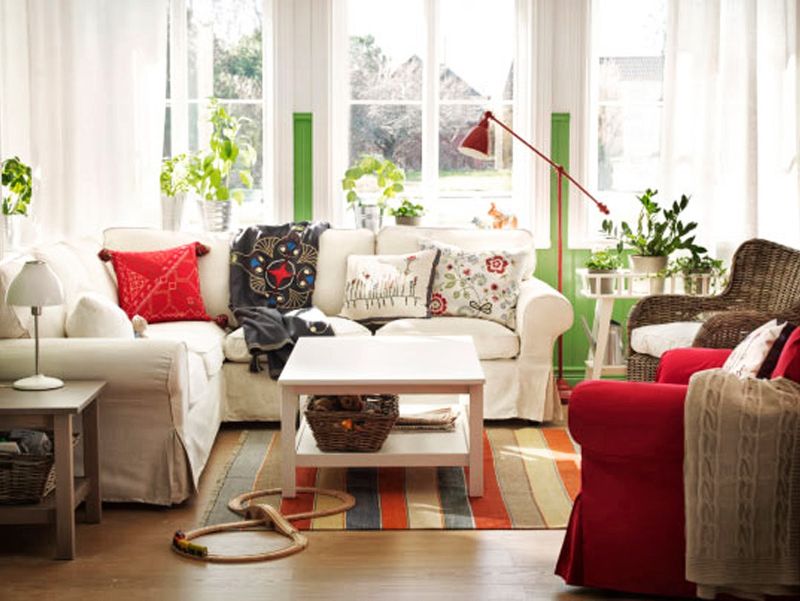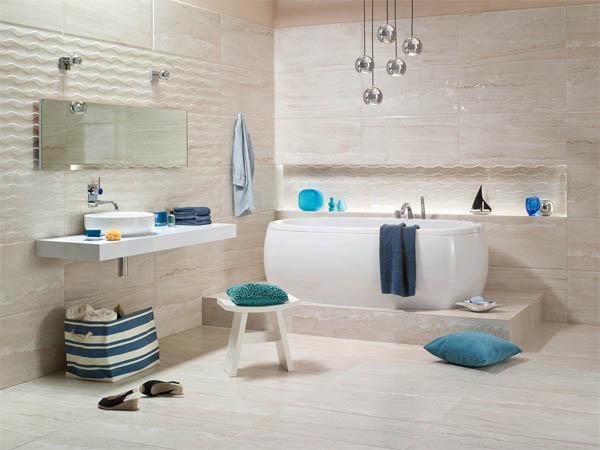If you’re familiar with feng shui, you’ll know that it is both an art and a science, developed anciently in China. “Feng” means wind, and “shui” means water. Feng shui delineates how to balance energies of a given space, large or small, in order to promote good health, fortune, and life energy, or chi, for those inside.

There are many aspects and variables that come into play in designing a space with feng shui in mind. (Check out homedit’s previous articles on incorporating feng shui into the office and bedroom.) Color plays a particularly important role. In fact, each color is an expression of one of the five elements of feng shui. You may have heard of them: fire, earth, metal, water, and wood. Color is used in specific areas of the home intentionally so as to bring about positive chi and harmony.

In this article, we will go through each of the five elements of feng shui, their associated colors, and how you could incorporate those colors into your decorating. Ultimately, the goal is to boost your energy and promote health and well-being. Sounds pretty good, doesn’t it?

Feng Shui Element: FIRE.

Fire represents high energy and passion – it supports life energy. Incorporating a balanced fire element into your space will bring activity and supporting energy to your life and career. The fire element is also believed to be strongly linked to love and sexual energy. Fire colors are: red, orange, vibrant yellow, purple, and pink.

Bold in their coloring, Fire elements take center stage in any space. Use them strategically and sparingly for an invigorating yet balanced effect.

With its energy-inducing Fire orange chairs and accents, this room defies anyone entering not to feel a surge of adrenaline.

Incorporating feng shui colors within Asian-inspired décor, such as this folding screen, is one way to achieve maximum design impact.

Showing that a little goes a long way, a softer Fire element-colored stripe paired with a few choice accents breathes energy but not chaos into this peaceful bedroom.

Unarguably dramatic, this deep floor-to-ceiling Fire element purple is invigorating and passionate. (The lime accents provide a modern twist.)
Feng Shui Element: EARTH.

Earth represents stability and nourishment – like Mother Earth. Incorporating a nurturing earth element into your space will help to bring peace, stability, and protection to you and your relationships. The earth element is also believed to play an important role in maintaining hope, health, and inner balance, as well as elevating mental activity. Earth colors are: beige/skin colors, sand tones, and light yellow.

A pale buttery yellow pairs with rich colors of the soil in this lovely Earth element-colored kitchen. Contemporary and warm, this space exudes friendliness and reassurance.

Perhaps a mixture of Earth and Wood elements, this living room is a welcoming and inviting space that would undoubtedly nurture relationships.

A corner nook filled with Earth element colors makes a lovely refuge.

Choose soft, sand-colored neutrals for large furniture pieces. This will go a long way in establishing an Earth element in your space no matter what happens elsewhere in the room

The feng shui Earth element in the bedroom results in a soothing and relaxing atmosphere perfect for unwinding at the end of each day.
Feng Shui Element: METAL.

Metal represents purity and precision. Incorporating an energetic metal element into your space will facilitate efficiency, focus, and precision, along with a strong sense of clarity. The metal element also helps to eliminate or avoid distractions while sustaining a calm, soothing chi energy. Metal colors are: metallics, gray, and white.

Warm metallics amp up the sophistication of a space and personify clarity and precision in its overall look and feel.

A gorgeous contemporary kitchen makes good use of the efficiency of the Metal element while also incorporating a balance of other elements.

A silvery grey velvet chair mimics the Metal element flawlessly…except you’d actually want to sit in it.

Even something as simple as a brass physician’s lamp and a similarly shiny vase on the living room coffee table will bring in the Metal element efficiently (how appropriate) and beautifully.

Of course, a little bling on the walls in the form of gold-leafed floral wallpaper never hurt anybody in the feng shui Metal element. Makes a perfect complement to the deep blues (Water element) here.
Feng Shui Element: WATER.

Water represents ease, abundance, and inner work. Incorporating a congruent water element into your space will result in a positive sense of calm, purity, and freshness. It enables our ability to concentrate, contemplate, and create. The water element also represents abundance (an ancient symbol) and wealth. Water colors are blue and black.

You don’t have to paint your entire room blue and lug in black furniture to incorporate the Water element into the space. Less is more when it comes to feng shui. Think in terms of the overall feel of pieces, both individually and collectively, to determine how they would work best in the feng shui color scheme.

Set against a blue wall, small-cut mirrors, such as the round mirror components of this sunburst mirror, are a lovely way to replicate sunlight’s shine on the water. The effect would be similar with crystals hanging from lighting fixtures or other glassy accessories.

The Water element walls in this bedroom nook provide a fresh oasis and nice balance with plenty of Wood elements elsewhere.

Paint one focal point in a Water element color, then throw in one or two corresponding accent pieces around the room to create a stunningly soothing space.

It’s no surprise how the waterfall table got its appropriate name; the smooth cascade of the top-into-leg is just like a waterfall. Tint such a table a very light blue, and you’ve got a perfect Water element to work with in your design.
Feng Shui Element: WOOD.

Wood represents growth and vitality. Incorporating the healing wood element into your space will bring about vibrancy and vitality in health and growth, as well as decisiveness and action. The wood element, including the use of plants, also motivates internal change and resonates with wealth and prosperity. Wood colors are brown and green.

Muted Wood element tones in fluid forms within this space create a very soothing, organic vibe.

A fresh, vibrant spring green plant provides the perfect touch of Wood element in a space with little color otherwise.

The incorporation of a few Wood elements (e.g., potted branches, a gorgeous twig-inspired orb pendant, and a parquet wood floor) ties all other elements together in this simple, modern space.

The raw natural substance that is Wood plays a key role in balancing with other non-similar materials, such as a porcelain tub or marble accent wall to provide warmth and vibrancy to the space.

Remember that wood needn’t be super heavy and dark; a light, airy representation provides a modern, refreshing aesthetic to the feng shui element.
You’re reading A Beginner’s Guide to Using Feng Shui Colors in Decorating , originally posted on Homedit. If you enjoyed this post, be sure to follow Homedit on Twitter, Facebook and Pinterest.
The post A Beginner’s Guide to Using Feng Shui Colors in Decorating appeared first on Home Decorating Trends – Homedit.
via. Home Decorating Trends